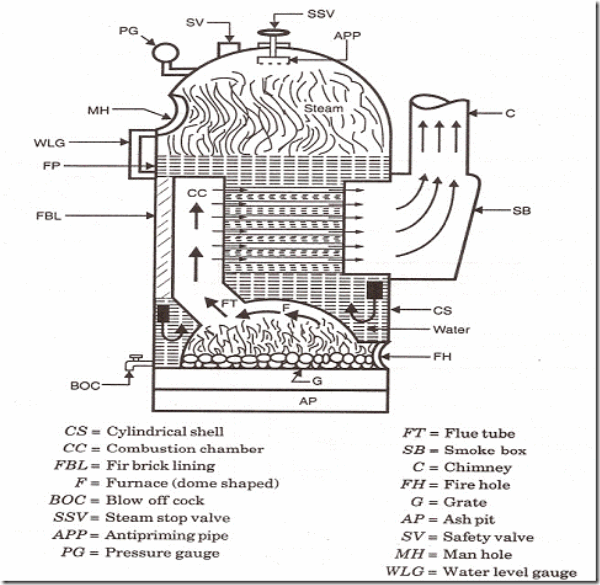To study the constructional features of COCHRAN BOILER
OBJECT
To study the constructional features of COCHRAN BOILER
APPARATUS
A model of COCHRAN BOILER
INTRODUCTION
FIRE TUBE BOILERS
These boilers essentially consist of one or more fire tubes passing through a cylindrical shell which may be horizontal or vertical and is filed to at least half of its volume with water.
Cochran boiler
Simple vertical boilers of the fire tube type find favour in small plants requiring small quantities of steam and where the floor area is limited. The most common applications are steam rollers, pile drivers, steam shovels, portable hoisting rigs and certain other mobile applications.
CONSTRUCTION
Cochran boiler, illustrated in Fig.1, provides an excellent example of the improved design of vertical, multi-tubular, internally fired natural circulation boiler.
The Cochran boiler essentially consists of:
(i) Boiler shell with hemispherical crown,
(ii) Furnace, fire box and grate,
(iii) Combustion chamber and flue pipes,
(iv) Smoke box and chimney; and
(v) Connections for boiler mounting and accessories,
CONSTRUCTIONAL AND OPERATIONAL DETAILS
The unit consists of a cylindrical shell with a dome shaped top where the space is provided for steam. The shell is formed of steel plates joined together with the rivets. Both the circumferential and longitudinal joints are lap joints made steam tight by fullering or caulking operation.
The fuel is burnt on grate in the furnace provided at the bottommost part of boiler. The furnace has no riveted seams exposed to flame and is pressed hydraulically from one plate to finished shape. This makes the furnace suitable to resist the intense heat produced by the combustion of fuel.
The grate consists of iron bars which are arranged with spacing between them. The spacing allows the air to pass onto the fuel for combustion.
The firebox is hemispherical so that the unburnt fuel, if any, is deflected back to the grate and complete combustion is achieved.
An ash pit is attached beneath the furnace for collecting ash after regular intervals. The boiler can be arranged to burn almost any kind of fuel including wood, paddy husk and oil fuel. For operation as an oil fired unit, an oil burner is fitted at the fire hole. The grate is then dispensed with a lining of fire brick is provided beneath the furnace.
Figure of COCHRAN BOILER
The coal, on burning, produces hot flue gases and these hot products of combustion from the fire box enter through the small flue pipe into the combustion chamber which is lined with fire bricks on the outer wall of the boiler. The lining prevents the shell from being damaged due to the overheating.
The dome shaped furnace and the combustion chamber prevent the loss which could otherwise occur because of combustion being retarded and much unburnt and combustible matter leaving the furnace. The unburnt fuel is deflected back to the grate and complete combustion, is achieved in combustion chamber where the high temperatures are maintained.
The hot gases passing through the horizontal smoke tubes give their heat to the water and in doing so convert water into steam which gets accumulated in the upper portion of the shell from where it can be supplied to the user. The flue tubes are generally of 62.5 mm external diameter and are 165 in number. The crown of the shell is made hemispherical in shape which gives the maximum space and strength for a certain weight of material in form of plates.
Finally the flue gases are discharged to the atmosphere through the smoke box and the chimney. The smoke box door enables the cleaning and inspection of the smoke box and fire tubes. Through a manhole provided at the crown of the shell, a man can enter the boiler for periodic cleaning and maintenance of the boiler. There are connections provided at appropriate places for fixing the usual boiler mounting such as pressure gauge, water level indicator, safety valve, steam stop valve, feed check valve and blow off cock etc.
Typical specifications of Cochran boiler are:
Size = 3 m diameter x 2 m high (evaporation 20 kg/hr)
= 3 m diameter x 6 m high (evaporation 3000 kg/hr)
Heating surface = 10 to 25 times grate area
Steam pressure = Up to 20 bar
Efficiency = 70 to 75%
The Cochran boiler is compact in design and there is good external and internal accessibility.

One Response to “To study the constructional features of COCHRAN BOILER | BME Lab Manual”
Pankaj Mishra
nice information, is it same as Scotch marine boiler?